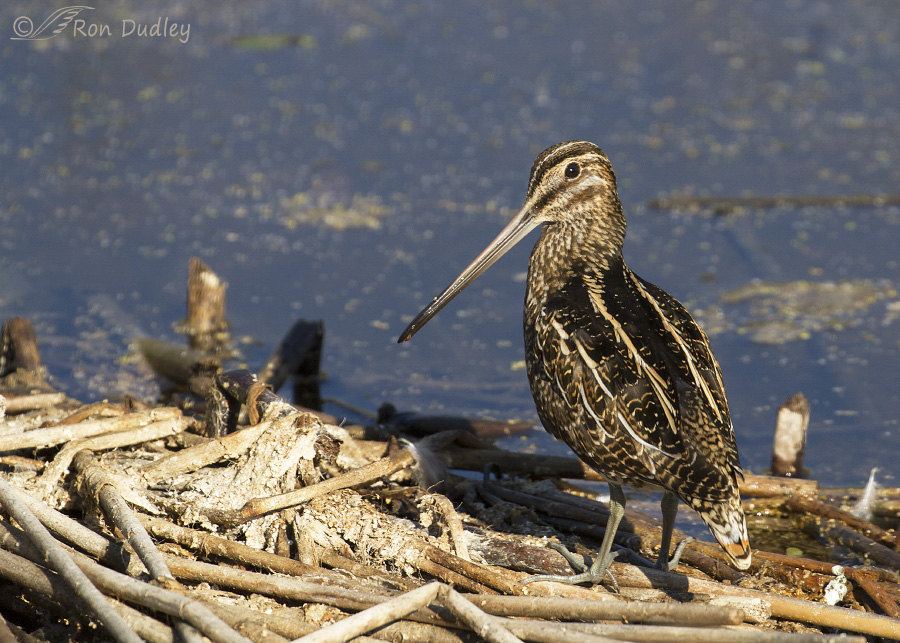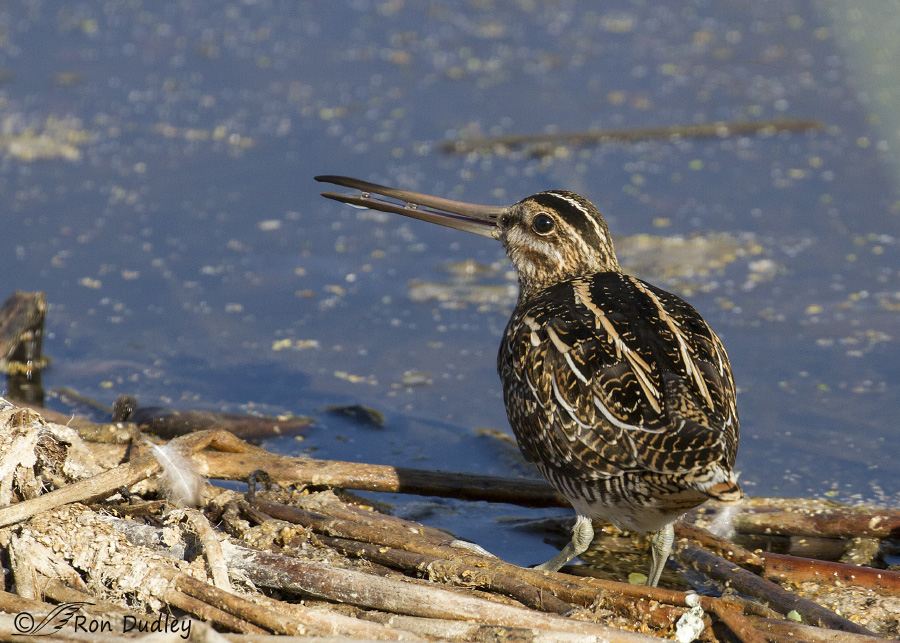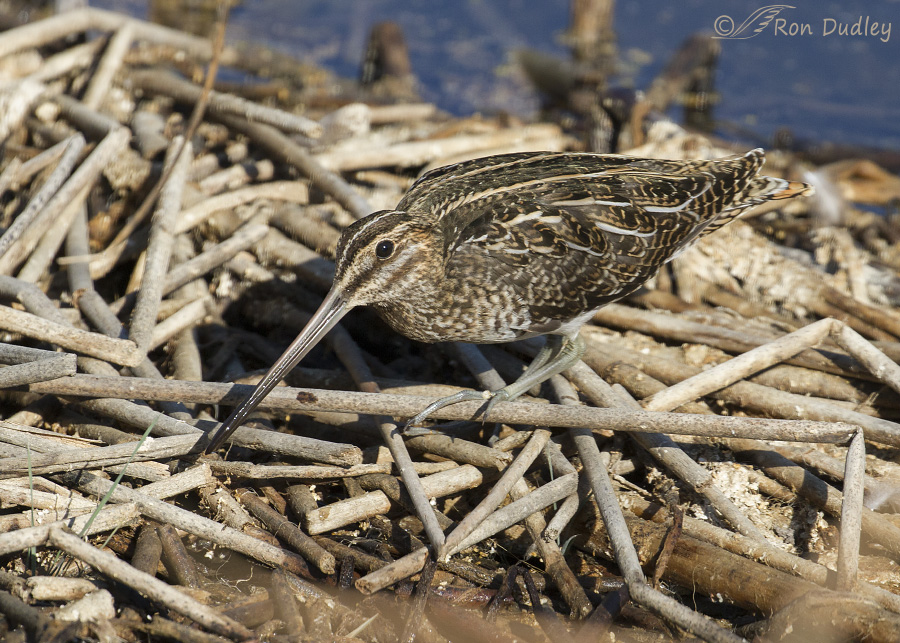The preferred habitat of the Wilson’s Snipe often isn’t pretty but they’re elusive enough that I’ll photograph them anywhere I get the chance.

1/1600, f/6.3, ISO 500, Canon 7D, Canon EF 100-400mm f/4.5-5.6L IS II USM @ 400mm, not baited, set up or called in
I photographed this snipe yesterday morning at Bear River Migratory Bird Refuge. The setting of messy water and rotting phragmites stems couldn’t be much more unattractive but it must look just fine to the bird so I’m okay with it too (sort of…).
I was quite close to the bird so I used my shorter zoom lens and older camera.

1/1600, f/6.3, ISO 500, Canon 7D, Canon EF 100-400mm f/4.5-5.6L IS II USM @ 400mm, not baited, set up or called in
When they’re drinking very few birds can suck water while their heads are down (pigeons and doves are an exception) so like most birds snipes must tilt their bills upward and use gravity to swallow. This snipe had just dipped its bill in the water and then tilted it upward to allow the water droplets to flow down toward its throat.
Cohesive forces have formed the two droplets into near-spheres so they look like little, clear marbles rolling down the channel formed by the mandible and maxilla of the bill.

1/1600, f/6.3, ISO 500, Canon 7D, Canon EF 100-400mm f/4.5-5.6L IS II USM @ 400mm, not baited, set up or called in
Then the snipe approached me even closer but soon after this shot was taken another vehicle came up from behind and I backed up to make room for it to pass. When I returned to the spot the bird was gone.
Over the years I’ve probably only had about a half-dozen good opportunities with snipes so I was pleased that this bird allowed me so close, despite the unattractive setting.
Ron


I would like to see a video of you out shooting some time. Someone filming you on a day of shooting. I would like to see how close that snipe was and what you were laying to get that shot
I’ll try to paint a picture for you, Joe – the next best thing.
I’m in a full sized pickup so I’m up fairly high. This bird was so close (guessing 15′) that I could barely point my long lens low enough out my window to get the bird in the frame – had to raise up in my seat to do it. There were reeds between the bird and us and I was trying to maneuver the pickup so two of us (one in the back seat) could get clear shots of it and that wasn’t easy, especially without scaring off the bird when I moved.
There was the frustrations of trying to keep the moving bird in focus, having to wait when it was showing a good pose but there were reeds in the way and then there was that damned car coming up behind me. I knew I’d have to move so it could pass when it got close so I was trying to watch it (the car) through my mirror and photograph the bird at the same time. Yes, there were some cuss words…
Interesting question you asked (though technically it wasn’t really a question).
The setting shows WHY this Snipe is hard to see. (and as a lifelong Girl Scout, I’ve led many a scout on snipe hunts.
(and as a lifelong Girl Scout, I’ve led many a scout on snipe hunts.  )
)
“Snipes!” Reminds me of Scout Camps in the early years. Argh!!
Ron –I love horses too much to beat even a dead one, but “the book” is already written. It only needs to be assembled…and not necessarily by you….Maybe someday, msny, many years from now, when you’re old and feeble, and those big lenses weigh a bloody ton…..and you have nothing else to do…..then, maybe…..
Maybe, Patty…
Snipe and owls!!! On the same morning! Happy dances.
And I love those water marbles too.
Megathanks.
I’m glad you got both itches scratched, EC. Thanks.
Water marbles or water pearls – they are attractive. You come up with some great terms, EC.
Snipe always seem to be in messy areas in my birding experience. Those light stripes on their backs really stand out through 8x binoculars and the long bill is often down in the mud.
I actually like the floating phragmites debris in this picture. The bird is beautiful, the detail is crisp, and the “raft” reminds me of one of my favorite books, “Kon Tiki”….
I remember that book.
Well for goodness sakes. Never seen a Snipe. I did not know they were real! I only know that in younger days the school boys always wanted to take the girls out Snipe hunting at night. Always figured it was a joke to lure the girls out in the dark for some kissing. I learn something new every day from your posts. Last laugh on me!
Trudy, part of your comment made me smile.
We also have Common Snipes in North America and the occasional (rare) visit from the Jack Snipe of Europe.
Interesting post and great images of this elusive bird Ron. I have only seen fleeting glimpses of snipes up in Katmai NP. A few years ago I heard the winnonwing noise they make when they dive and I was convinced it was a boreal owl calling, frequently a confusion of hearing a even more reclusive bird.
Ed, I’d love to see that behavior and hear that sound one day. Probably won’t happen though – here in northern Utah we’re right on the edge of their breeding range and I believe that’s a breeding behavior.
Looks like you take great pictures regardless of equipment. Idea…. Why don’t you put a book together of Birds of Utah. It would give you a little extra money for your camera equipment. Your pictures are so awesome. I really think you should. And have several pictures of each species. One sitting for good look and another for wow(/flying, catching prey eagle eating carp while flying. ) your book would be awesome!!!!!!
Marina, the book idea has been floated by me before, many times. Heck, I just don’t have the time. I’m already in over my head just keeping up with my photography and my blog. Thanks for the confidence in me though…
You only have to supply the pictures and the comments…all of which you already have…and a “co-author”, partner, to help you coordinate them . They could be organized re:habitat, type of bird (ex.waterfowl, song, raptors, etc.). I have a nutty friend who used to be a “ghost writer” but lost his senses and went into local politics where, miracle of miracles,he is loved and respected by all…probably because he’s one of the most irreverant, no nonsense, honest, straight forwardest, funniest men I know! No one even wants to run against him….
Excellent shots, and what makes it for me is the habitat that the Snipe is in. Thank you for not trying to pretty the picture!
Dick, I think it would take a magician to “pretty up” these photos!
Sometimes the price to pay to have a bird’s image is a less than appealing environment.
The only image I have of a Snipe was taken some years ago on the Azores Islands and I was lucky to find it near a road, coming out of the woods.
We name it here “Narceja”.
I was curious about the answer you gave to Todd Henson. Would you mind showing me one or two of those old images of Barn Owls you took from a tripod? I guess they weren’t easy to catch.
Thank you.
I’d be happy to. Check back in a few hours and I’ll post some links. Right now I am out on Antelope Island.
Interesting to know the Portuguese name for snipe, Jorge. Thanks.
Here’s a link to some of my very early flight shots of Barn Owls, all taken with a tripod.
https://www.featheredphotography.com/blog/2010/11/02/barn-owls/
Great shots Ron. I like them all.
What a skill you already had back then.
Thank you very much for showing me those wonders.
These are incredibly beautiful images of one of my favorite birds! Thank you, Jorge (“Jose”–The devil made me say that! )for getting Ron to repost them!!! What treat they are!!!
I’ve never seen a “snipe” Ron. The pictures and commentary are great.:) Even if the footing is messy I like having context for the birds.
I guess context is context, Judy – messy or not.
Here we go again–OH WOW! What a gorgeous bird and again, lovely images. Good to know they actually exist so I can send my next apprentice out to find one! LOL!
Good to know they actually exist so I can send my next apprentice out to find one! LOL!
So that’s what a snipe looks like! I’ve never seen one and actually wondered if there were really such a bird or if they were a similar species to a jackalope. I’ve only ever heard about them in terms of sending a falconry apprentice off on a snipe hunt
You’re not the only one who thought that, Laura. “Snipe hunts” have fooled some folks for years, in more ways than one.
You made me wonder about what actually ate snipe. I thought harrier was a probability from field situations in WI but BNA has more predators.
“Adults are taken by Great Horned Owl, Peregrine Falcon, Merlin, Northern Goshawk, Cooper’s Hawk, and Northern Harrier; (Bent 1937, 1938). Northern Harrier probably the most important (Tuck 1972).”
I don’t think this is an appropriate target for an apprentice bird or apprentice falconer even if they’re flying a harrier but there’s the American slang of sending all kinds of innocent folks on s snipe hunt. For raptors, there’s too much plant material in the way and only a few species seem to be able to catch these guys in their mucky, emergent plant filled habitat.
And that also made me wonder if people actually ate these small birds. They have huge breasts; so, probably, like mourning doves with Cajuns, you just cook the breast and feed the rest to the livestock or pets. (But Cajuns used the rest of the bullfrog after removing the legs in a tomato based sauce in the 1970’s.)
“And that also made me wonder if people actually ate these small birds”
Yes, they eat them, Pam. Examples below:
http://www.thesnipehunter.com/page26.html
This sounds a lot like my Cajun comments. He uses the breast and feeds the rest to dog or…. depending on what you have. And he is connected to the natural environment and its cycles.
HAHAHA again…and Cajuns will eat just about anything. Love those folks!
LOL Pam…our minds traveled the same paths/gutters! I wasn’t thinking of sending the apprentice’s bird out on that hunt. That wouldn’t be fair! Just the apprentice Joking, of course, but still.
Joking, of course, but still.
And I think pretty much anything wrapped in bacon is good.
Sensational shots of this elusive bird Ron!!
Charlotte
Thanks, Charlotte.
The setting my be unattractive, but the bird shows up beautifully, which is what counts. I especially like the shot with the water droplets. Thanks for introducing me to a bird I’ll likely never see.
Susan, they’re found on almost the entire continent so the primary trick to seeing them is finding one out in the open. That often isn’t easy though…
Good Morning, Ron.
Interesting post as usual. Always one of my first reads of the day because I know I’ll probably get schooled on something and I firmly believe in learning something new everyday. If I could just retain it, I’d be…
I notice that the backup is still the ole trusty 7D. Did you ditch the other 7D2?
Thanks very much, Neil.
I still have my original 7dII. My plan is to send it to Canon and get it fixed, then I’ll have to decide whether to sell it or use it as a backup but so far I’m just procrastinating…
Ron, I agree, the backgrounds may not be attractive from an artistic perspective, but from a naturalistic or environmental one they’re perfect, showing the snipe’s habitat. And as always, I love your descriptions and images showing different behaviors. You’ve captured images of another bird I’ve yet to see, though I think we do have these out here for part of the year. I’ll need to keep my eyes open. Are you able to use your vehicle as a blind for most of your images?
Todd, I photograph from my vehicle roughly 95-98% of the time. In the places I typically shoot I have a much better chance of getting close to birds in my pickup than I do on foot. Birds tend to be much less fearful of vehicles than they are of humans on foot.
I have a 9 year old, expensive and heavy-duty Gitzo tripod with Wimberly head that still look new I’ve used them so little.
That said, when you need a tripod you NEED a tripod! For example, most of my older images of Barn Owls in flight were taken from a tripod.